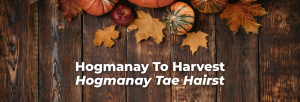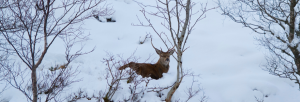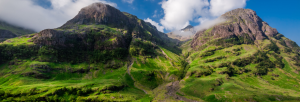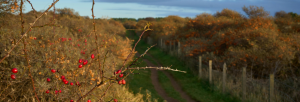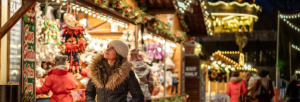Hear from storyteller and Director of the Scottish International Storytelling Festival, Donald Smith, as he takes us through a range of Scottish and multicultural seasonal customs, suggesting simple yet effective ways one can encourage enjoyment and participation through recognising small changes in the seasons.
January
New Year begins with acts of kindness and hospitality and with promises for the time ahead.
The emphasis is on sharing with animals (given extra food at New Year) and with everyone in the community. The Burns Festival is ideally placed to connect with these winter themes.
Activities and Resources:
Feeding birds and animals. Looking after pets. Traditional stories of winter kindness and helping through frost, ice and snow e.g. ‘Robin and Fir Tree’, ‘The Elves and the Shoemaker’, ‘The Brounies’, ‘The Trows’ and other fairy helpers.
Robert Burns as a baby born in winter storm, early life, songs (many winter songs), and poems (kindness to animals, plants and people). Burns Suppers as hospitality and cultural feasts. The Right Wee Ceilidh, with joining in – like Circle time/Story circle. Some Burns songs, poems and stories may be more useful at other seasons.
February
The first signs of spring as the days get longer.
The Feast of Bride/Candlemas nurtures the early signs of life and looks forward to spring.
Activities and Resources:
Seeing snowdrops (symbol of Bride), and bulbs sprouting. Beginning to clear gardens ready for spring, as weather allows. The story of Bride and Angus, the struggle to bring in the spring despite winds and frosts, and the power of the winter Queen.
Bride Suppers – making soup and bannocks with cheese and cakes. Lighting of candles/lamps to show the light is returning. In some parts of Scotland, corn dollies (see August) are now dressed as Bride with shawls etc. and decorated with bright and shiny things to reflect light. Explore stones and minerals that keep their colours and brightness through the winter.
March/April
The Coming of spring is a time of new life and growth, celebrated by all cultures across the world that experience seasonality.
This is an opportunity to engage creatively with the local environment in a global context.
Activities and Resources:
Life cycle activities of seeds, flowers, leaf buds, eggs, frog spawn etc. Enjoy different names, Scots and Gaelic, for plants and animals as a way of exploring language. Planting outside and cleaning inside commences. Consider a focus appropriate to your local environment – river/lochs/sea/hills/park. Use stories and songs incorporating new life, young animals and birds nesting, the salmon’s journey to lay eggs, chickens hatching, lambs, mice, rabbits, hares, calves, deer, otters, beavers etc. These may fit around your choices of rivers/mountain/loch/sea, so bringing in ways of life on sea or land – fishing, farming, gardening, growth of towns and cities in key locations. Use songs and stories about sea, lochs or mountains.
Pancake Day (The Wee Pancake/Bannock), Feast of Fools (jesters/Comic Relief) were all designed to relieve the austerities of Lent, leading up to Easter itself, with its colours – Easter bonnets, eggs and cards. Easter gardens and flowers are important in Christian celebrations.
April/May
May Day/Beltane opens the way to summer.
With Hallowe’en/Samhainn it is one of the two major turning points in the Scottish year, as life finally moves into a more outdoor mode. Preparing for May Day, and following on from it, are packed with cultural and environmental possibilities.
Activities and Resources:
Planting and cleaning continue. Woods and trees/bushes, freshwater springs and wells are a focus for this seasonal transition, with washing in dew/fresh water at Mayday and the bringing in of the first leafy boughs. Sun cakes made and decorated. Gathering greenery and dancing with music/percussion, with green costumes/hats/decorations/garlands/flags all began here leading into the summer season of gala days and processions.
The May Queen, Robin Hood (Lowland) and Finn McCool (Lowland and Highland) stories relate to moving out to the woods and hills. Stories/songs of outdoor life, sports, games, camping and journeys.
June/July
Summer/Midsummer crown the school year.
According to Billy Connolly there are only two seasons in Scotland – June and Winter – so celebrating these weeks in culturally appropriate ways is important to the lives of families and communities.
Activities and Resources:
Following on from May, summer term activities include picnics, games, fairs, races/obstacle courses, and outings. All offer specific activities and cultural connections with opportunities for songs, stories and dancing. Eating and cooking outdoors is associated with singing/storytelling, informal games/performances, and puppet plays.
The Gala Day tradition continued in many forms which can be harnessed or recreated/adapted for early years’ purposes and activities connecting school, community and environment. Midsummer stories include the dancing trees (e.g. Auld Cruivie in Aberdeenshire) and the fairy celebrations in rings/hills. Outdoor tents/shelters, games, dances and parades can be play opportunities as well as events.
HARVEST TO MIDWINTER/HAIRST TAE YULE
August
Harvest inaugurates the school year.
The harvest cycles link endings with beginnings and offer rich thematic opportunities.
Activities and Resources:
- Display barley/wheat/oats and explore milling, baking, porridge making. Make hay from long grass. Salad vegetables, peas and beans can be picked, prepared and eaten. Harvest displays include decorations with sheaves and corn dollies using stalks and ribbons. Harvest suppers, ceilidhs and harvest songs.
- Stories of harvest include John Barleycorn, harvest mice, and plenty for birds and animals but also the hunting of game birds, hares and rabbits – dangers of harvest time. Note also other harvests – shearing for wool, and river fishing.
September
September, like March, is a transitional month.
Harvest themes continue but with an increasing emphasis on change.
Activities and Resources:
- A good time for exploring woodlands and parks – leaves turn and nuts including conkers can be found. Berries are harvested allowing fresh fruits, puddings, pies and jam. Fallen branches can be gathered and things made from wood. Mushrooms can be gathered but not toadstools- funguses/mosses/lichens etc with good or bad effects depending on use. Bees, wasps and mini-beasts. Mice and squirrels are storing for the winter. Birds gather berries.
- Stories of woods and forests, nuts and woodland creatures. Some birds are migrating and others preparing to leave. Some animals get ready to sleep for the winter. Dogs and horses are busy with working or racing as summer ends. Experiences of travelling near and far.
October
Harvest ends in October, and the last day of the month brings the second major seasonal turning point – Hallowe’en, or Samhain.
The earth tilts finally from light to dark, outdoor to indoor. Again, preparations for this Festival formed an important aspect of Scottish cultural life. The symbolism of light in darkness also connects with many other cultural traditions and festivals, including Diwali.
Activities and Resources:
- Apple, pear and plum harvests. Autumn vegetables – cabbage, turnip, and pumpkin. As days shorten, preparations for Hallowe’en begin – masks, decorations, lanterns and shadow puppets. Stories of light and dark evoke fears to dispel and reassure. Consider night creatures – owls, bats, badgers, foxes.
- Prepare rhymes, songs, poems, and costumes for Guising. Dooking for apples, sticky scones. Hallowe’en cakes. Opportunities for free play as well as structured activities. National Poetry Day. Use Scots and Gaelic rhymes/songs/phrases.
November
The St Andrew’s Season is a natural opportunity to explore specific aspects of Scottish culture that are helpful to different curricular themes.
Activities and Resources:
- A good month to explore the culture and identity of your own area as well as overall Scottish themes. What are the important places, people and stories? Often local ‘culture’ is neglected as too low key or obvious, but there is great potential in reconnecting children and families with things they take for granted or ignore around them. What can be celebrated in the children’s own environment?
- Scottish food, language, dances, stories, textiles (tartan/tweed/wool), costumes, crafts, flags, songs and music can deliver across learning objectives and create a positive mood in a potentially low period, leading up to St Andrews tide.
- ‘Scotland Sings’ and National Book Week take place in late November.
December
Preparing for Christmas/Yule is the major theme with all the potential and appeal of the Christmas story.
Midwinter customs of gifts, gift bearers, hospitality and plays/entertainment, are interwoven with Scotland’s combination of Christmas and Hogmanay – the Twelve Days. This is an inclusive approach to celebrating Christmas.
Activities and Resources:
- Christmas songs, carols, stories, decorations, cards. Nativities, concerts, puppet plays and parties.
- Christmas as a community celebration – giving, sharing and helping as winter sets in. Christmas trees, lights of welcome and kindness in winter cold and darkness. Opportunities for cross-generational connecting and sharing. Christmas in past times and Christmas themes in other countries, cultures and faiths, which may be represented in the community. A time for peace and goodwill.
Overview
- General Working towards a holistic Scottishness – celebrating where we all live and belong. Dovetail specific cultural resources and opportunities with the calendar cycle, seasonal opportunities and the main curriculum strands. The importance of belonging.
- Resourcefulness as well as resources – adapt, improvise and create. Change stories and songs to fit, invent patterns, events and traditions to suit your situation or context – that is what community culture has always done. Be inspired by culture, not constrained.
- We are all storytellers! Have ‘right wee ceilidhs’ as part of regular activity areas so that all children are affirmed and confidence grows through joining in. ‘Tell a story, sing a sang.’





